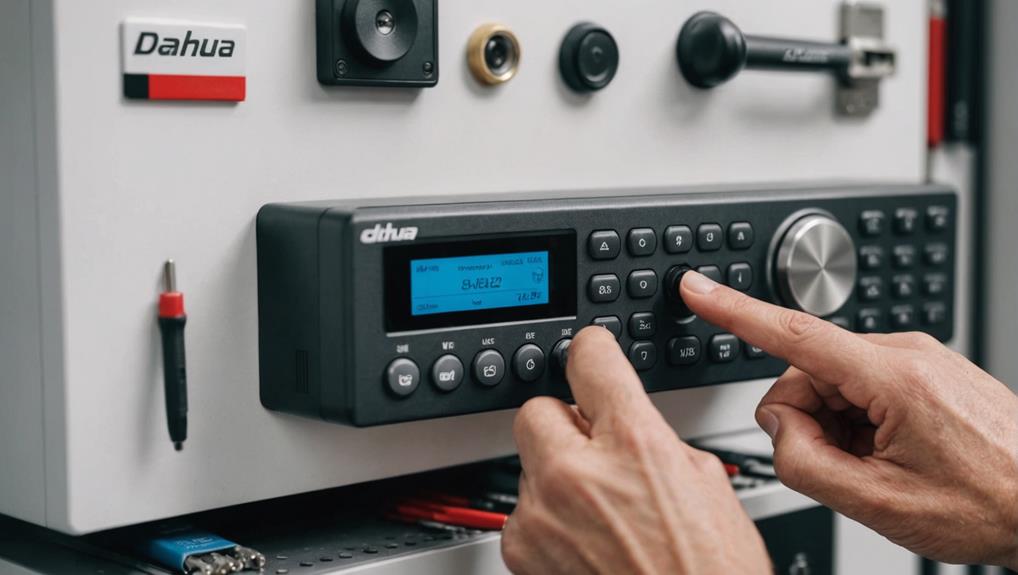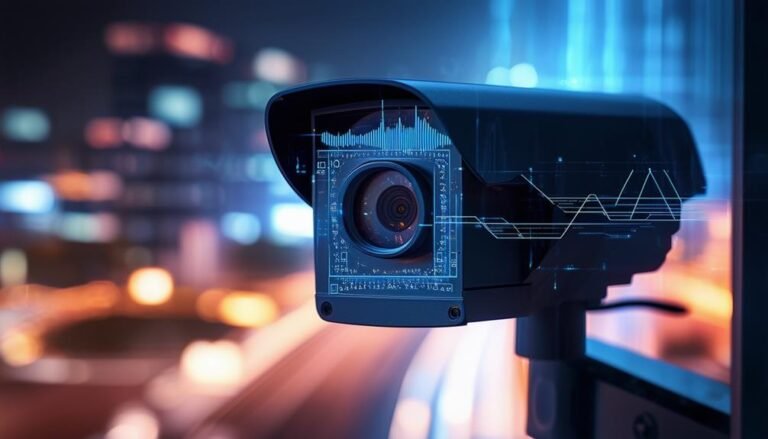To reset your Dahua DVR, start by determining which reset type you need: a soft, hard, or factory reset. For a soft reset, simply power off the device, wait 10-15 seconds, and turn it back on. If issues persist, perform a hard reset by unplugging the DVR, locating the reset button, holding it down while reconnecting power for 10-20 seconds, and letting it reboot. If you’re locked out and need to reset your password, pressing the reset button for about 10 seconds will restore default settings. Stick around to discover more detailed steps and tips for optimizing your system!
Understanding DVR Reset Types
When it comes to resetting a Dahua DVR, it’s essential to understand the different types of resets available. This knowledge empowers you to choose the right method based on your specific needs, helping you regain control over your device and ensuring it operates smoothly.
There are generally three types of resets you can perform: a soft reset, a hard reset, and a factory reset. A soft reset is often the most straightforward option, involving simply restarting the DVR. This method can resolve minor glitches without disrupting your settings, allowing you to maintain your personalized configurations.
Next, there’s the hard reset, which usually involves using the reset button on the device. This type of reset clears temporary data and settings but keeps your recorded footage intact. It’s perfect for situations where the system’s misbehaving but you’re not ready to lose all your saved recordings.
Finally, the factory reset is the most drastic option, wiping everything and returning the DVR to its original settings. While this gives you a clean slate, it also means losing any custom configurations and saved footage. So, if freedom from a malfunctioning system is what you crave, this might be the way to go.
Understanding these types of resets allows you to navigate your options confidently, ensuring you make the choice that best suits your situation, restoring functionality while preserving your autonomy over your security setup.
Preparing for the Reset
Before diving into the reset process, it’s important to prepare your Dahua DVR to guarantee a smooth experience. Taking a few moments to get everything in order can save you time and frustration down the line. Here’s what you should do:
- Backup Important Data: Confirm you’ve saved any critical recordings or settings. You don’t want to lose valuable footage during the reset.
- Gather Necessary Tools: Have your remote, power cable, and any other required equipment handy. This way, you won’t scramble last minute when you need something.
- Check Power Supply: Verify your DVR is connected to a reliable power source. A sudden power loss during the reset could cause issues.
How to Perform a Soft Reset
A soft reset is often the quickest way to troubleshoot minor issues with your Dahua DVR without losing any data. This method can help refresh your system, clear temporary glitches, and restore normal functionality. The beauty of a soft reset lies in its simplicity; you won’t have to worry about losing your recordings or settings.
To perform a soft reset, start by locating the power button on your DVR. If your device has a remote control, you can also use that to turn it off. Once you’ve found the power button, press it to turn off the DVR. Wait for about 10 to 15 seconds. This brief pause allows the system to clear any temporary files or cached data that might be causing issues.
After the waiting period, press the power button again to turn it back on. As the system reboots, give it a moment to restore your settings and load all your recorded data. It may take a minute or two, so be patient. Once it’s back up and running, check to see if the problems you were experiencing have been resolved.
If everything’s working well, you’re good to go! A soft reset can often provide you with the freedom to enjoy your surveillance system without the hassle of more complicated troubleshooting methods. Remember, this is a quick fix; if issues persist, consider exploring other reset options.
Steps for a Hard Reset
If you’re still facing issues after trying a soft reset, a hard reset might be essential to restore your Dahua DVR to its factory settings. This process can help clear out any lingering problems and give you a fresh start. Just keep in mind that a hard reset will erase all your settings and recordings, so make certain you back up any important data before proceeding.
Here’s how to perform a hard reset:
- Power off the DVR: Unplug the power supply from your device.
- Locate the reset button: Usually, this is a small pinhole found on the back or bottom of the DVR.
- Press and hold the reset button: While holding the reset button, reconnect the power supply. Continue holding the button for about 10-20 seconds until you see the device reboot.
Remember these key points:
- Backup important data: Before resetting, verify you’ve saved anything essential.
- Know your settings: Be ready to reconfigure your DVR settings post-reset.
- Patience is key: Allow the device ample time to fully reset and initialize.
Once the reset is complete, your DVR should be back to its original state, free from the previous issues. Enjoy the newfound freedom that comes with a fresh start, and take the time to set up your preferences as you like!
Resetting Passwords on Dahua DVR
Forgetting your password can be frustrating, especially when you need to access your Dahua DVR. But don’t worry; resetting it isn’t as complicated as it may seem. First, verify you have the DVR handy and connected to your monitor. You’ll want to access the login screen; if you’re locked out, look for the “Forgot Password” option. This feature can guide you through the reset process.
If you can’t find the “Forgot Password” option or it doesn’t work, you’ll need to perform a factory reset. This usually involves physically accessing the DVR. Locate the reset button on the device—it’s often a small hole that requires a pin or similar object to press. Hold this button for about 10 seconds while the DVR is powered on. Once you release it, your DVR should reboot, and you’ll gain access to the default settings.
The default username is typically “admin,” and the password may be “123456” or “admin.” It’s crucial to change this password immediately to protect your device from unwanted access. Make sure to create a strong password that you can remember, combining letters, numbers, and special characters.
As you regain access, take a moment to explore the settings and features of your Dahua DVR. Familiarizing yourself with these will empower you, giving you more control over your security system. Now that you’re back in, you can enjoy the freedom of managing your surveillance needs effectively.
Troubleshooting Common Issues
Troubleshooting common issues with your Dahua DVR can save you time and frustration. Whether it’s a connectivity problem or a video playback issue, addressing these concerns quickly means you can get back to enjoying the freedom of knowing your surveillance system is working smoothly. Here are a few common problems and quick fixes you might encounter:
- No Video Signal: Check if the DVR is powered on and that all cables are securely connected. Sometimes, a loose cable can cause a complete video blackout.
- Playback Issues: If you can’t play back recorded footage, verify that the hard drive is functioning properly. You might need to format it if it’s new or experiencing issues.
- Network Connectivity Problems: If you’re unable to access your DVR remotely, check your internet connection. Restart your router and check firewall settings to make sure they’re not blocking access.
Post-Reset Configuration Tips
After resetting your Dahua DVR, you’ll want to verify everything is set up correctly for peak performance. Start by accessing the device’s settings through the main menu. Confirm that your time and date are accurate, as this is vital for recording and playback. You wouldn’t want to miss important footage because of a simple time error.
Next, check your camera configurations. Make sure each camera is properly assigned and has the correct resolution settings. If you’re using multiple cameras, it’s wise to label them clearly for easy identification. You can adjust the frame rate to guarantee smooth video without overloading your storage.
Don’t forget about your network settings. If you’re using remote viewing, verify that your DVR is connected to your Wi-Fi or Ethernet. Test the connection to confirm you can access your footage from anywhere. Consider setting up alerts for motion detection, so you’re instantly notified of any activity.
Lastly, take a moment to review your storage settings. Decide how much footage you want to retain and set up overwriting preferences if necessary. This can help you manage your storage space, giving you the freedom to keep the footage you deem important.
Frequently Asked Questions
Will Resetting My Dahua DVR Delete Recorded Footage?
Resetting your Dahua DVR can be a concern, especially when you’re worried about losing your recorded footage. Generally, a factory reset will erase all settings, including recordings, so it’s essential to back up any important videos beforehand. If you’re looking to maintain your recordings, consider other troubleshooting methods that don’t involve a full reset. Always prioritize your freedom to access your footage without losing valuable content in the process.
Can I Reset the DVR Remotely?
Yes, you can reset your DVR remotely, but it depends on the model and software version. Typically, you’ll need to access the device through its web interface or a dedicated app. Once logged in, look for the settings or maintenance section where you can find the reset option. Just remember, resetting might affect your settings and recorded footage, so it’s wise to back up anything important first. Enjoy the freedom of managing your DVR from anywhere!
What Should I Do if the Reset Fails?
If the reset fails, don’t worry; you’ve got options. First, double-check your connections and verify everything’s powered properly. If that doesn’t work, try a hard reset by unplugging the device for a few minutes. Sometimes, updating the firmware can help too. If those steps don’t solve the issue, consider reaching out to customer support for additional guidance. Remember, persistence is key, and you’ll get it working again!
Is There a Warranty on My Dahua DVR After a Reset?
You might think resetting your Dahua DVR could void its warranty, but that’s not always the case. It often depends on the specific terms set by the manufacturer. If you’re feeling trapped by issues, a reset can offer freedom, yet it’s wise to check your warranty details first. Don’t let uncertainty hold you back—review your documentation or contact support to clarify what’s covered, ensuring you stay informed and empowered in your tech journey.
Will I Need to Reconfigure My Network Settings After Resetting?
Yes, you’ll need to reconfigure your network settings after resetting your Dahua DVR. A reset typically clears all settings, returning the device to its factory defaults. So, you’ll have to re-enter your Wi-Fi credentials and any other specific configurations you had in place. It might feel tedious, but think of it as a chance to optimize your setup for better performance and security. Embrace the freedom of customizing it to your needs!



